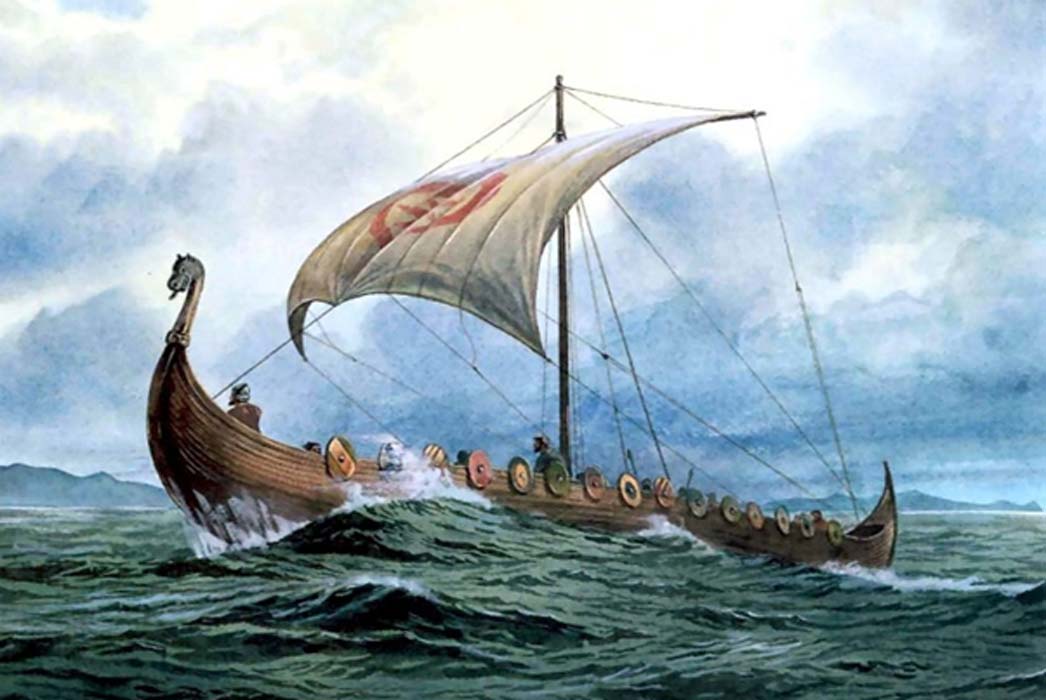Discovery of Two Boat Burials Changes Viking Timeline
According to accepted accounts, the Viking Age began in 793 AD off the coast of northern England when the first raid of Scandinavian warriors is recorded to have taken place. The Vikings emerged suddenly and expanded rapidly across Europe, Asia and the Americas. Although the Vikings are known to have originated in Scandinavia, there is little known about how and why they suddenly built ships and took off in search of new lands. Was it climate change, overpopulation, desire for wealth or simply a thirst for adventure? Whatever it was, the Vikings made a lasting impact on the world. But is all we know about them correct?
The Beginning of the Viking Storm
A discovery on a Baltic Island nearly a decade ago, shed new light on how the Viking storm first began. “Two ships filled with slain warriors uncovered on the Estonian island of Saaremaa may help archaeologists and historians understand how the Vikings’ warships evolved from short-range, rowed craft to sailing ships; where the first warriors came from; and how their battle tactics developed,” reported Archaeology Magazine. “Between them, the two boats contain the remains of dozens of men. Seven lay haphazardly in the smaller of the two boats, which was found first. Nearby, in the larger vessel, 33 men were buried in a neat pile, stacked like wood, together with their weapons and animals. The site seems to be a hastily arranged mass grave, the final resting place for Scandinavian warriors killed in an ill-fated raid on Saaremaa, or perhaps waylaid on a remote beach by rivals”.

The remains of 33 men buried in the ship that brought them from Scandinavia to an Estonian island Credit: Liina Maldre, University of Tallinn
Does the Discovery Change Accepted Timelines?
The men are believed to have died in battle up to a century before the Viking Age officially started, an era that wasn’t previously known for long voyages. The ruins of the two boats display a high level of technological advancement, a transformation which had been taking place in the 8 th century Baltic. They were clearly capable of open-sea travel.
The first boat, which had no sail and would have been rowed from Scandinavia, is believed to have been constructed around 650 AD. Evidence suggests it had been repaired and patched decades before its final voyage. The second boat was far more sophisticated. Although it had largely deteriorated, the discovery of a keel – a feature essential for keeping a sailing boat upright – suggests the Scandinavians were sailing in the Baltic at least a century before accepted timelines say they were.

One of the skeletons found aboard the smaller ship. Credit: Marge Konsa, University of Tartu
Evidence of Boat Burial Suggests More Gradual Emergence of the Vikings
Experts believe the two boats are the remains of a boat burial, a ritual strongly associated with the Vikings. The finding suggests that this tradition had gradually evolved over centuries and did not just emerge suddenly in the Viking Age.
The finding of the two boats is significant as it supports a new perspective of the Vikings, suggesting that the start of the Viking Age wasn’t as sudden as previously believed, but was a more gradual process. It now seems that the Scandinavian warriors developed and enhanced their ship-building skills over several centuries, eventually reaching a level that allowed them to take off in the open ocean, reaching faraway lands and leaving their traces across four continents.
Top image: Illustration of a Viking ship (public domain)


















Comments
Scratch that, I found the link near the top to the original Archaeology.org article. :D
Does anyone have a different source fo this article? After browsing around the trashy articles on Ancient Origins, I don’t want to use them as a source.
These were not danes but swedes, proven by the DNA test they did..
About Greenland and bosnians:
In Mongolia you should search for a statue of bosnian queen Katarina, around age og Khans. One of Bosnian kings have also had a titel "Khulan Ban".
Vatican cheated that woman queen Katarina, back in old days, because Bosnian Church was differently special and didn´t want to follow Vatican. Vatican today claims that Vatican "helped" to Katarina, but it is not true.
Because of contact with mongols, some Balkan people have back in old days had no difficulties to communicate with inuit people from Greenland.
Knud Rasmussen have been much later working for Royal House, some witnesses travelling with him are killed by him, others let to die of hunger and Knud Rasmussen as the only one claiming to speak inuit language have survived... In that way Knud Rasmussen could claim Greenland to belong to Danish Royal House, even though vikings who were Balkan people have came to Greenland as the first one of white people a long time ago. It was just a trick between norwegians and canada and denmark, in front of court in Haag.
P.S.:
Old Viking "religion" had a flag with black Raven bird, before christianity. Danish flag "falled from heavens" on 15/ juni, having red and white color.
Serbs had Kosovo Battle on 15/ june, Kosovo has a name of Common Blackbird, serbs have a red and white Coat of Arms.
What danes later call "Ase-tro" (religion), is actually a belief from period of Asen Dynasty in bulgaria.
Find a book called "Early protestants of the East".
Still untill this day today the Vatican and Monarchies rule the world, it is just the people been stupid and not informed and lazy to reaserch.
Pages